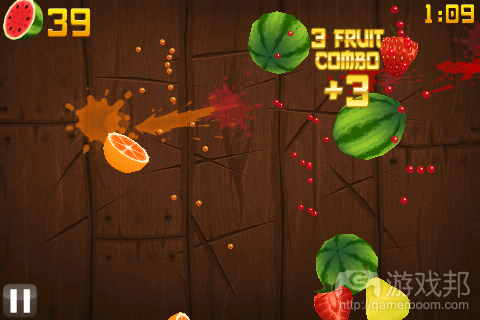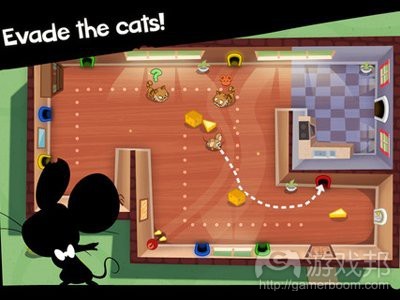Halfbrick和Firemint高管谈如何连推成功之作
作者:Mark Serrels
出自澳大利亚开发商之手的《水果忍者》和《航空指挥官》都获得了巨大的成功,但是要如何实现在逐渐发展的iOS市场中复制成功呢?
将来的方向
Firemint创始人兼首席执行官Robert Murray带领着负责《航空指挥官》的团队,他声称:“从根本上来说,我们要做的首件事情就是开始探索每个可行的游戏想法,每个工作室成员构思出的想法。”
尽管获得了成功,但Murray仍显得很谦虚,他表示《航空指挥官》的成功完全在意料之外。但是,在游戏获得巨大成功之后,确保Firemint再获成功的重担便落在他的身上。
他继续说道:“我们进行了长期的试验,而我认为接下来最重要的事情是将所有这些试验抛开!如果想要再次制作出成功之作,就必须在某个项目中花足够的时间和精力。《航空指挥官》的成功得益于公司在行业、想法和计划上的经验。对我来说它只是个小项目,我猜你也认为它的成功只是巧合。但是接下来我们要做的就是找准整个工作室前进的方向,思考用户真正的游戏需求。”
制作原型(游戏邦注:也就是制作游戏运转的主体内容和概念框架)似乎是游戏设计中最重要的事情,尤其是在iOS游戏开发中。当你主动去寻找下款游戏巨作时,原型制作就变得特别重要。
Murray说道:“锁定你认为有潜力的目标然后将其不断深化和改进,经历整个开发和投资过程。或许一段时间后,我们又能够制作出有着极具吸引人的体验的游戏。我们的规划是:不要频繁改变自己的目标,将时间和精力集中在一个目标上。”
原型的重要性
Halfbrick营销总监Phil Larsen在采访中也提到了“原型”这个词。
他手上握着iPod touch,开始说道:“《水果忍者》就是从原型发展演变过来的。我们公司有个名为‘Halfbrick Prototype Fridays’的活动。在活动中,我们集思广益,分享想法。我们每两周举办一次这个活动,活动结束后往往会产生出将近10个可玩的游戏原型。随后,我们快速浏览和分析这些想法,从中找出下个项目的方向。”
根据Phil的说法,你会在某一刻知晓某个游戏原型有成功的潜力。他声称:“就《水果忍者》而言,未成形时我们就知道它有成功的潜质。”
Firemint采用的方法似乎更有条理,从各种不同的原型中挑选中意的目标,然后投入时间和精力将其制成产品。Halfbrick更倾向于快速研发多个想法,借鉴其他游戏中的机制,改进并加入自己独特的东西。《Monster Dash》便属于此类作品,公司最新产品《Machine Gun Jetpack》也是采用这种方法制成的。
Phil说道:“我们让团队的方向多样化发展。我们采取的做法是,以我们看到的游戏想法为基础深入开发。比如,我们将某个单键游戏演变成了现在的《Machine Gun Jetpack》。这便是我们公司的能力,从其他游戏中获取灵感后制作出顶级的游戏。”
虽然现在寻找到全新的概念以几乎不可实现,但在这个日益拥挤和竞争激烈的市场中,原创性仍然非常重要。
“虽然我们希望还能够构思出有成功潜力的想法,但这确实是件很困难的事情!我们不可能总让产品成为市场巨作,没有人能够做到这一点!不可能永远都有完全原创的想法。”
长远规划
Murray说道:“我们经历过整个开发和投资过程。近期员工投入大量时间,努力完成《实况赛车2》的开发。因而无论我们选定什么项目,整个公司都会围绕该项目运转。”
Firemint最著名的产品是《航空指挥官》,该游戏在iOS上的售价仅为1.19美元,所以你可能会认为它是个只有几个员工的小型独立工作室。但事实情况是,Firemint有逾60名雇员,在付费游戏方面投入颇大。
他继续说道:“《实况赛车》是我们的第2款游戏,同样也算是巨作,但它售价10美元,所以没有出现在排行榜前列,但iPad版本曾位居排行榜首位。《实况赛车2》是续作,已经开发了18个月,投入资金超过200万美元。”
Nick Haggar是Blue Tongue的项目总监,他只负责主机游戏的制作,但是他很认同Firemint和Blue Tongue之类的开发商。他认为,公司应当立足于小范围成功继续发展。
Haggar说道:“我觉得这些游戏成功的时候,iOS市场相对较为乐观,但是现在事态正在发生改变。看看《无尽之剑》之类的游戏。一旦制作出同种质量的游戏开发成本下降,那么一次性游戏将来就不可能再获得成功。”
Robert Murray表示,自己在游戏行业中的经验对《航空指挥官》的成功至关重要。Haggar也强调了这点。
Haggar说道:“看看澳大利亚获得成功的这些游戏产品,你就会发现它们往往都是那些有着悠久游戏制作历史的工作室的产品。那些刚刚涉足游戏设计领域的人很难制作出优秀作品。如果你的目标是制作游戏并将其投放到应用商店中,那么掌握基本游戏设计方法就足以实现。但是如果你的目标是成为成功的开发商,那么这就需要拥有工作室文化和支撑你制作更多游戏的基础资源。要实现上述目标,发展是惟一途径。构建手机游戏工作室的目标在于维持盈利渠道的多样性。看看那些在iOS市场成功的人,你会发现他们都是经验丰富的开发者。他们的游戏制作生涯并非从iOS游戏开始,他们之所以可以在转向这个新市场后取得成功,是因为他们有一定的经验,知道如何制作游戏。”
Firemint设计总监Steven Fawkner认为,虽然有长远规划很有必要,但专注于细节同样重要。
“我认为,独立游戏开发者更应该着眼于细节,因为你无法实现宏伟目标!你只能实现些小目标,而思考细节便是良好的考段。我更偏向于注重产品的质量。你可以有较大的规划,比如制作多人游戏或开放世界,但是你也需要考虑尽量将产品润色,使之能够引起玩家的注意。”
结合各种优势
为寻找到发展之路,Firemint和Halfbrick都必须改变他们的发展进程和想法,因为玩家对公司产品质量的期望以及公司内部的诉求都有所提升。
Murray说道:“我认为随着时间推移,用户会逐渐期望游戏有更大的产品价值和丰富内容。看看电视节目的发展历程就明白了,最早你对电视节目的要求并不高,但现在电视节目的产品价值与剧院中的作品相当。”
他继续说道:“我们确实需要融合各种体验,我们需要付费休闲内容,我觉得公司在这方面可以做得很好。《航空指挥官》趣味性十足,所以很显然简单机制可以创造出丰富的趣味性,但是我们也感觉到人们仍然想要获得更丰富的体验。你想要易用性较强的东西,同时也希望这些东西的发展能够超出预期。我们的下款游戏名为《Agent Squeak》,游戏优先保证休闲性和较强的易用性,但同样有着惊人的深度。”
Phil Larsen是Halfbrick的营销总监,所以他将注意力放在改善新iOS游戏的推广渠道上。但是他也表示,游戏本身的质量是最为重要的。
他说道:“你必须确保自己制作出的是优秀的游戏。劣质游戏不可能获得成功。你需要确保游戏能够在平台上完美地运行。比如,《水果忍者》与iPhone平台间就有着完美的契合度。”
尽管如此,他确实掌握着某些营销技巧。
他继续说道:“营销是种你需要不断研究精炼的技术。当然,我有自己的方法!比如,现在每个人都会利用社交网络进行推广。但从营销的角度上说,你必须向用户呈现精美的截图和视频。”
对Halfbrick和Firemint之类的工作室来说,成功产生了一定的挑战。《水果忍者》和《航空指挥官》使得这两家工作室有了继续成长的机会,但是从另一方面来说也带来了挑战:成功有可能再次眷顾同个开发者,但开发者需做足成功的准备。
但是游戏的成功同样让这两个工作室获得了一定的经验,他们似乎已全副武装,准备用自己独特的方式来应对挑战。Firemint的《Agent Squeak》是付费休闲内容可行的完美例证,Halfbrick也已经给单键iPhone游戏披上鲜亮的外衣。
游戏邦注:本文发稿于2011年4月13日,所涉时间、事件和数据均以此为准。(本文为游戏邦/gamerboom.com编译,拒绝任何不保留版权的转载,如需转载请联系:游戏邦)
Halfbrick And Firemint: Making Lightning Strike Twice
Mark Serrels
Both Fruit Ninja and Flight Control were huge success stories from Australian developers – but how do you replicate that success in the constantly evolving iOS marketplace? We spoke to both Halfbrick and Firemint and asked them one simple question – how do you make lightning strike twice?
Lightning never strikes twice. It’s a common urban myth, but exactly that – a myth. Nothing could be further from the truth. Lightning can, and frequently will, strike twice – in the precise same spot. The Empire State Building is struck roughly 25 times a year. Roy Sullivan, an ex-US Park Ranger was hit by lightning seven times and survived… before killing himself years later via a self inflicted gunshot wound.
Precisely how and why lightning strikes twice is a more interesting question – it’s an imprecise science, difficult to measure. Manufacturing the circumstances necessary to make it happen is even more difficult.
But that’s precisely what Halfbrick and Firemint, creators of iOS megahits Fruit Ninja and Flight Control respectively, are attempting to do – recreate the rapid success of two unique phenomenon.
So as an Australian developer, with one massive success under your belt, how do you proceed? How do you make lightning strike twice?
WHERE TO NOW?
“Fundamentally one of the first things you do is start exploring every game idea possible. Every idea that comes up in the studio,” claims Robert Murray, CEO and founder of Firemint, the team responsible for Flight Control.
Murray, despite his success, is quietly spoken – extremely humble – and willing to admit that the success of Flight Control was a complete surprise, a side development that exploded beyond his or anyone’s control. After the grand success of the game, it’s now his responsibility to make sure Firemint can repeat it.
“We’ve been through a long period of experimentation,” he continues. “And I think the most important thing to do is throw all those experiments away! You’ve got to spend the time and the effort if you want to make another hit. Discovering Flight Control was a combination of experience in the industry, thought and planning. It was a small project for me, and I guess you could say it was like a lightning strike. But what we’ve done afterwards is try to get the whole studio to be prototyping and thinking about customers what want from a game.”
Prototyping – the act of creating a bare bones, functioning concept of how a game will work – appears to be paramount when it comes to game design. Particularly in iOS development -particularly when you’re actively attempting to search for the next big thing.
“So you go through that process,” continues Murray, “then you go through the investment process. You lock something down that you think has potential – then you take it further, and then you throw half of that away again! You have to get past that! Now we’re a year into production with a finished game that’s the charming experience that we want it to be. For us, the answer is simple: don’t short change yourself and invest wisely.”
PROTOTYPE FRIDAYS
Speaking to Phil Larsen, Marketing Director at Halfbrick, that word comes up again. Prototype.
“This is how Fruit Ninja came about,” he begins, with an iPod touch clutched between his paws. “We have a thing called ‘Halfbrick Prototype Fridays’. Where we try and brainstorm ideas. Every time we do that, which is every two weeks, we come back with about ten games – ten playable prototypes. So we can quickly go through these ideas and get a rough idea of what is going to work.”
According to Phil there are moments when you simply know when one of these prototypes is going to work as a fully fledged video games. That’s when lightning strikes.
“For Fruit Ninja, we knew that was going to work when it was just a pitch,” he claims, “before it was even a game, we knew it would be awesome.”
Whereas Firemint’s process appears to be more methodical, working stringently through different prototypes, investing in ideas that may never come to fruition, Halfbrick are happy to give multiple rapidly developed ideas a shot, grabbing mechanics seen in other games, polishing them and adding their own unique twist. Monster Dash was an example of that, as is their latest effort – Machine Gun Jetpack.
“We’ve been able to diversify our teams a bit,” says Phil. “What we’ve done is taken ideas that we’ve seen around, and taken them to the next level. Like one button games, which we’ve tried to evolve with Machine Gun Jetpack. That’s part of our strength – plenty of top games take inspiration from other games.”
But originality – and finding a unique niche within an increasingly crowded, competitive marketplace – remains key, even if finding that new concept is next to impossible.
“We’re always instinctively trying to come up with the next idea for a big hit – it’s hard! It’s interesting – we can’t always make the next huge, phenomenal hit – no one can! You can’t be super original every time.”
THINKING BIG
“We go through phases,” says Murray quietly. “A lot of the time the guys are just working their guts out on finishing Real Racing 2, or whatever project we are working on – so once you’ve locked something down it’s all systems go.”
Firemint are best known for Flight Control, which is a low budget $1.19 game on iOS, so by that rationale you would expect it to be a small, indie-style studio with a handful of employees. But the fact is, Firemint has over 60 employees, and invests heavily in premium content.
“Real Racing was our second game and it was a hit,” he continues, “but it was a ten dollar hit, so it was never going to be on top of the charts – although it was number one when it came out on iPad. Real Racing 2 is a sequel which has been 18 months in development and had over two million dollars of investment.”
As Project Director at Blue Tongue, Nick Haggar works on console games exclusively – but he has a healthy respect for developers like Firemint and Blue Tongue. In his opinion, taking success on a small scale and attempting to build from that starting point is essential.
“I think the iOS thing is good at the moment,” claims Haggar, “but you’re even starting to see that transform. Look at games like Infinity Blade. That landscape is shifting. Once it becomes cheaper to produce games of that quality, all those disposable games – Dave Perry calls them Kleenex games – may not be as successful in the future.”
Robert Murray claimed that his experience in the games industry was paramount to the success of Flight Control. Haggar was also keen to emphasise the same point.
“Look at the games that have come out and been successful from this country – they have come from really longstanding studios with longstanding reputations,” says Haggar. “It’s not as if it was someone who had a great idea in the last year of their design course and – bang – I’ve knocked it out. If your goal is to make a game and get it on the app store then, yes, you can get there, but if your goal is to succeed as a developer – which is a separate goal – which is to create a studio culture and a resource base that allows you to capitalise and make more games – and build from that – then, in my mind, the only way is up. You’re trying to build your studio so that you can continue to stay in business with multiple revenue streams. If you look at those guys who are successful in the iOS space, they are seasoned developers. They did not start by creating iOS games – they moved here because they have the experience and they know how to make games.”
Steven Fawkner, Firemint’s Design Director believes that while think big in terms of scope is necessary – focusing on the details is equally as important.
“I think as an Indie you’re encouraged to think small because you can’t make a big thing! You can only make a small thing, and that’s a good place to start. I don’t like think of it in terms of thinking big, I like to think of it as thinking quality. You can think big in scope – multiplayer, open world – but you also need to be thinking, ‘let’s polish it until it shines.’”
BUT WILL IT BLEND?
In search of the next big thing, both Firemint and Halfbrick have had to evolve their processes – as a result of increased expectations of quality, and internal motivations.
“I think that consumers will come to expect significant production values and significant content from simple games over time,” claims Murray. “Look at TV when it started – you would initially expect low production values because it was just TV, but now TV has comparable values to cinema.”
“We actually want to blend it,” he continues, “we want premium casual content and I think that’s what we can deliver so well. Flight Control is a great amount of fun, and obviously a lot of the fun is derived from a simple mechanic, but we also feel that people still want that richer experience. You want something accessible, but something that’s going to grow well beyond your expectations. Our next title Agent Squeek is casual and accessible up front but it has surprising depth – that’s where we see ourselves.”
Phil Larsen from Halfbrick is a Marketing Director, so he’s focused on improving the various ways he can promote new iOS titles but, according to him, the quality of the game itself is all important.
“You have to make sure you have a good game,” he claims. “You can’t put out a bad game and expect it to do well – not going to happen. You need to make sure it’s perfect for the platform – Fruit Ninja works perfectly on the iPhone, for example.”
That being said, he does have a few tricks up his sleeve.
“Marketing is definitely a technique that you have to refine,” he continues. “I have my ways! Like building in social networking functionality – that’s just something that everyone should be doing nowadays, because that’s easy. But in terms of marketing you have to make sure you have great screenshots, and trailers and organise coverage.”
For studios like Halfbrick and Firemint, the challenges that come with success are palpable. Fruit Ninja and Flight Control have enabled both studios the license to push forward and grow, but from that imperative comes a new set of challenges – lightning can strike twice, but you have to be prepared and ready to capture that lightning in a bottle.
But with success comes experience, and both studios – in their own unique ways – appear fully equipped for the challenge. Firemint’s Agent Squeek is the perfect example of premium casual content, whilst Halfbrick have polished the one-button iPhone game to a fine sheen.
In the iOS market nothing is certain – nothing is guaranteed. But it’s great to see Australian developers leading the charge. (Source: Kotaku)
下一篇:持续创新是抵御克隆现象的最佳策略











































